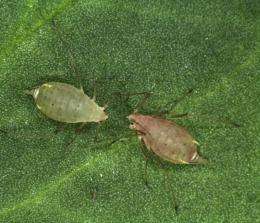Color-changing bacterium inside the pea aphid

A bacterium that can live symbiotically inside the pea aphid, Acyrthosiphon pisum, is able to change the insect’s body color from red to green, a RIKEN-led team of molecular entomologists has found. Because body color affects how other animals are attracted to aphids, infection with the bacterium is expected to impact on interactions with other symbiotic organisms, predators and parasites. Studies of the molecular mechanism behind the color change could lead to technologies for generating pigments more efficiently, and also for changing the appearance of some organisms, the researchers say.
Both red and green forms of pea aphid occur in natural populations. Previous research by other workers has shown that body color is correlated with the presence or absence of a single gene, and that red is dominant. Ecologically, the balance between the colors is maintained because the most important predators, ladybug beetles, preferentially eat red aphids, while parasitoid wasps attack the green form.
While screening aphids collected in France, Tsutomu Tsuchida from the RIKEN Advanced Science Institute in Wako, together with colleagues from France, and from other Japanese research institutions, found several strains of green aphids with red young that turned green as adults.
Studies by Tsuchida and other researchers have demonstrated that symbiotic bacteria play a role in the adaptation of pea aphids to particular varieties of plants and to high temperature, as well as in the development of resistance to natural enemies. On investigating the symbiotic bacteria in Western Europe, the researchers found that about 8% of pea aphids are infected by a previously unrecognized species of Rickettsiella bacteria. Measurements of growth rate, body size and fecundity of infected aphids showed no negative impact on fitness.
By generating separate lines of aphids infected and uninfected by Rickettsiella, Tsuchida and his colleagues were able to show that uninfected red aphids always retained their color, as did all green aphids. Not all infected red aphids turned green, but the color change from red to green was always associated with Rickettsiella. In fact, the intensity of green color depended on the level of infection. The researchers thus concluded that the color change depended on an interaction between the Rickettsiella and aphid genomes.
“We are now extensively analyzing the genome sequence of the symbiotic bacterium and symbiont-induced gene expression of the host aphid,” Tsuchida says. “These analyses should show us the molecular and metabolic interplay that leads to the body color change.”
More information: Tsuchida, T., et al. Symbiotic bacterium modifies aphid body color. Science 330, 1102–1104 (2010). Read the article here: www.sciencemag.org/content/330/6007/1102.abstract
Provided by RIKEN

















